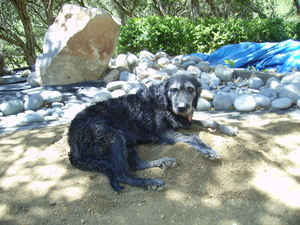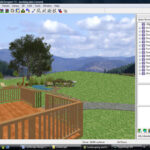One popular feature that you’ll often see in landscape design these days is the dry river bed. It is seen quite often in modern landscapes in the West, because it is a way to use rocks creatively, in a way that mimics nature, and also is a way to define space in landscaping.
I recently designed and built a dry river bed in my front yard after I decided to get rid of my lawn. I did this because I have lousy soil, was tired of dealing with it, and wanted a front yard that looked good but was low-maintenance and didn’t use much water.
I’m quite happy with the way it turned out, but did learn a number of valuable lessons in doing this myself.
First of all, I had the lawn removed. The next step was to dig a shallow channel in which to lay the rocks. Some people dig a straight ditch for the channel; I chose to make mine curved and winding in order to offset the straight lines of the house and adjacent flower beds.
The channel actually ended up taking quite a bit of time because my soil is clay and full of rocks, and in retrospect, I should have hired someone with a strong back to do it. It ended up taking me about 10 hours over a period of a few weeks.
Next, I covered the entire front yard area in weed cloth to prevent weeds from growing up in the middle of my dry river bed. The weed cloth must be cut to fit and then staked.
I chose river rocks for my dry river bed, which sounds like a natural choice, but there are quite a few different kinds of rocks to choose from when you visit landscaping supply yards. River rock is naturally rounded and has a pleasing shape to it; you can choose all one color or several colors. I chose rocks that were a bluish-gray, light brown and dark brown.
I had these rocks delivered as well as a few larger boulders as accent pieces.
To hide the black weed cloth, I first put down a layer of decomposed granite (also known as d.g.), which is finely crushed rock that is often used for pathways. Then I started laying down the river rocks in the channel. This also ended up taking a lot of time, since I ended up rearranging the rocks several times. I had to look them over for a while and decide which rocks belonged where. It’s kind of like doing a jigsaw puzzle – one with big heavy pieces.
I finally found that the best look for my dry river bed was to put the smallest rocks in the middle of the channel with larger rocks on the edges of the channel. A few of the very largest rocks I used to accent the start of the river bed and to enhance a few of the curves.
Lastly, I planted some New Zealand flax in a few spots around the river bed to soften the starkness of the rocks. I will probably continue to add some more drought-resistant plants as time goes on and I decide exactly where I want them.
Source:
Personal experience




